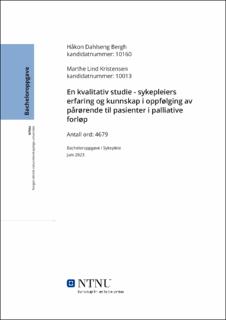| dc.contributor.advisor | Aune Anne Grethe | |
| dc.contributor.author | Bergh Håkon Dahlseng | |
| dc.contributor.author | Kristensen Marthe Lind | |
| dc.date.accessioned | 2023-07-18T17:20:14Z | |
| dc.date.available | 2023-07-18T17:20:14Z | |
| dc.date.issued | 2023 | |
| dc.identifier | no.ntnu:inspera:146721298:147643656 | |
| dc.identifier.uri | https://hdl.handle.net/11250/3080012 | |
| dc.description.abstract | Sammendrag
Bakgrunn og hensikt
Med en karriere innenfor sykepleie, møter man døden som er en naturlig del av livet. Dette stiller krav til at sykepleiere skal inneha kunnskap og kommunikasjonsverktøy som ivaretar både døende pasienter og pårørende.
Hensikten med studien var å undersøke hvordan sykepleier kan ivareta pasient og pårørendes i deres siste tid sammen, og hjelpe pårørende videre i livet. Vi ønsket samtidig å undersøke om sykepleiers erfaring innenfor palliativ pleie påvirket bruken av kommunikasjon med pårørende.
Metode
Studien er utført etter kvalitativ metode for å innhente dybdekunnskap om erfaringer og fenomener som oppstår i kommunikasjon mellom pårørende og sykepleier. Datainnsamling foregikk gjennom semistrukturerte intervjuer basert på en intervjuguide med åpne spørsmål og oppfølgingsspørsmål. Til sammen intervjuet vi 4 sykepleiere ved en privat institusjon som utøver palliativ pleie.
Resultat
Funn i vår studie viser en sammenheng mellom erfaring og bruk av kommunikasjon med pårørende. Sykepleierne med mest erfaring innenfor feltet bruker i større grad klinisk blikk og erfaring for å kartlegge behovet til pårørende, mens mindre erfarne sykepleiere i større grad støtter seg mer på andre kolleger og yrkesgrupper ved de vanskeligste temaene. Studien identifiserte også at kommunikasjon med pårørende i all hovedsak oppsto spontant, og miljø og arkitektur på avdelingen hadde innvirkning på samtalens oppstandelse, innhold og egnet arena.
Konklusjon
Avslutningsvis viser vår studie i lys av annen forskning at sykepleierens erfaring og dens bruk av kommunikasjon bidrar til best mulig ivaretagelse av pårørende til den døende pasienten. | |
| dc.description.abstract | Abstract
Background and purpose
Faced with a career in nursing, the encounter with death comes as a natural part of life. This requires nurses to inhibit both knowledge and the communication tools that look after both the dying patient and their relatives.
The purpose of the study was to investigate how nurses can look after patients and relatives in their last moments together, and help relatives further in life after loss of their loved ones. Furthermore we wanted to investigate whether nurses' experience with end-of-life care affected their experience of communication with bereaved relatives
Method
The study was carried out using a qualitative method to obtain in-depth knowledge about experiences and phenomena that arise in communication between relatives and nurses. Data collection took place through semi-structured interviews based on an interview guide with open questions and follow-up questions. In total, we interviewed 4 nurses at a private institution that practices palliative care.
Result
The findings in our study show a connection between experience and use of communication with relatives. The nurses with the most experience in the field use a clinical perspective and experience to a greater extent to assess the needs of relatives, while less experienced nurses rely more on other colleagues and professional groups for the most difficult topics. The study also identified that communication with relatives mainly arose spontaneously, and the environment and architecture of the ward had an impact on the origin of the conversation, content and suitable arena
Conclution
In conclusion, our study shows, in light of other research, that the nurse's experience and use of communication contribute to the best possible care of relatives of the dying patient. | |
| dc.language | nob | |
| dc.publisher | NTNU | |
| dc.title | En kvalitativ studie - sykepleiers erfaringer og kunnskap i oppfølging av pårørende til pasienter i palliative forløp. | |
| dc.type | Bachelor thesis | |
